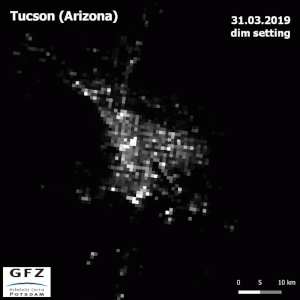
When satellites take pictures of Earth at night, how much of the light that they see comes from streetlights? A team of scientists from Germany, the USA, and Ireland have answered this question for the first time, thanks to “smart city” lighting technology that allows cities to dim their lights. The results were published in the journal Lighting Research & Technology.
The team conducted an experiment by changing the brightness of streetlights in the city of Tucson, Arizona, U.S., and observing how this changed how bright the city appeared from space. Dr. Christopher Kyba from the GFZ German Research Center for Geosciences led the team that conducted the experiment and said the work is important because it shows that smart city technologies can be used to perform city-scale experiments.
“When sensors and control systems are installed throughout an entire city, it makes it possible to make a change in how the city works, and then measure the impact that change has on the environment, even from outer space,” Kyba said.
Over 10 days in March and April of 2019, Tucson officials changed the brightness settings for about 14,000 of the city’s 19,500 streetlights. Usually, most streetlights in Tucson start out at 90 percent of their maximum possible illumination, and dim to 60 percent at midnight. During the experiment, the city instead dimmed lights all the way down to 30 percent on some nights, and brightened them up to 100 percent on others.

Animation of satellite images of Tucson, U.S., on nights with bright and dim street light settings during the experiment. Image courtesy of Andreas Ruby (Universität Trier, Germany).
The city lights were observed by the US-operated Suomi National Polar-orbiting Partnership (NPP) satellite, which is famous for its global maps of light at night. The satellite took cloud-free images of Tucson on four nights during the test, and on two other nights with ‘normal’ lighting after the test. By comparing the city brightness on the six different nights, the researchers found that on a normal night, only 20 percent of the light in satellite images of Tucson comes from streetlights.
The results have important implications for sustainability, according to study co-author Dr. John Barentine from the International Dark-Sky Association. In a second experiment conducted at the same time, Barentine and his co-authors showed that Tucson’s street lighting accounts for no more than 14 percent of the artificial light in the night sky detected at the zenith, confirming that most of the sky brightness over Tucson also comes from other sources.
“Taken together, these studies show that in a city with well-designed streetlights, most of the light emissions and light pollution come from other sources, such as lit signs, facades, or sport fields,” Barentine explained. The authors say that local and national governments, therefore, need to think about more than just street lighting when trying to reduce light pollution.
According to the researchers, the changes in the streetlighting brightness are barely perceptible, as people’s eyes quickly adapt to the light levels. They report that the city received no comments or complaints about the changed lighting during the test. There is also no evidence or suggestion that reducing lighting levels as part of the experiment had any adverse effect on public safety.
Kyba is therefore excited by the idea of performing such experiments more regularly and in other municipalities. “Instead of dimming lights to the same level late each night, a city could instead dim to 45 percent on even days and 55 percent on odd days,” Kyba suggested. “City residents wouldn’t notice any difference, but that way we could measure how the contribution of different light types is changing over time.”